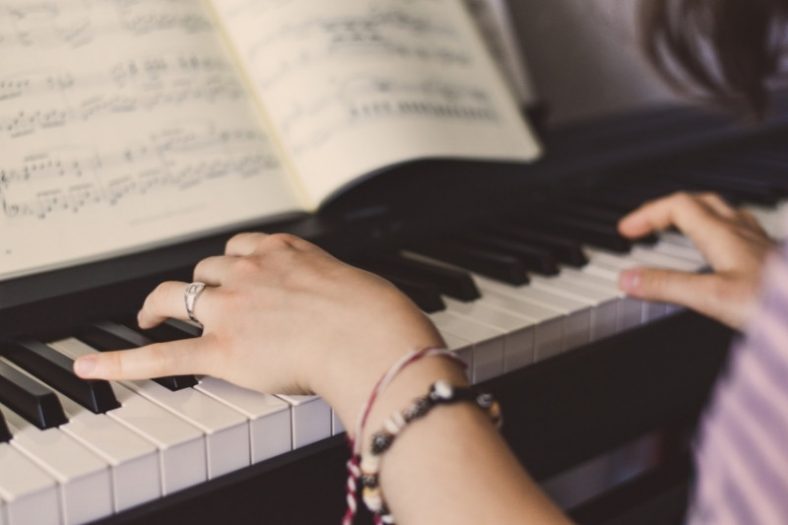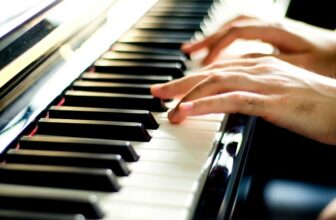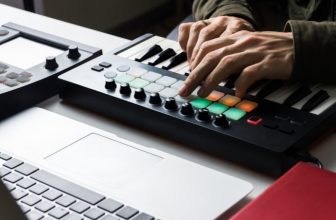The 10 Most Popular Piano Styles

It can be challenging for a piano student to decide which piano style to learn. There are many different piano styles with different characteristics and playing techniques that require different practices. Learning different styles beforehand can greatly help you choose the ideal one for you.
From classical piano to boogie-woogie, there are many different approaches to the piano in terms of sound, playing, and style. Each style has different things to offer to musicians and requires different training. To be a good pianist, you should be comfortable with at least a few of these playing styles.
The following are some of the most popular piano styles you can explore to determine which ones you prefer.
Contents
- 1. Classical Piano
- 2. Jazz Piano
- 3. Gospel Piano
- 4. Blues Piano
- 5. Musical Theater Piano
- 6. Pop Rock Piano
- 7. Country and Western Piano
- 8. Liturgical Piano
- 9. Boogie-Woogie Piano
- 10. Cocktail Piano
- What are other popular alternative piano styles?
- What are the benefits of learning a new style of piano playing?
- Conclusion
1. Classical Piano
Starting with the most traditional one, classical piano is the richest style in the piano world. To play the classical piano properly, you need to learn many techniques and skills as it is one of the oldest and hardest playing styles. Considered the base for music education, most beginners start with classical piano.
As the name suggests, classical piano refers to playing classical music with a piano. As most music originates from classical music, classical piano is considered the starting point in piano music. There are countless songs in style for any level pianist.
Some of the most popular classical piano songs are “Für Elise” and “Moonlight Sonata” by Beethoven, “Canon in D” by Pachelbel, and “Prelude No. 1 in C Major” by J.H Bach. Some other famous classical piano composers are Haydn, Chopin, Handel, Wagner, Debussy, and Tchaikovsky.
2. Jazz Piano
One of the most popular piano styles is jazz piano, which came to the music scene in the early 20th century in the U.S.A. It is arguable the hardest piano style as jazz music deviates from classic harmony, rhythms, and technique. Players need to be very comfortable with their techniques and need to have a high musical knowledge to play jazz piano.
Pianists like Scott Joplin, Jelly Roll Morton, and Fats Waller had big influences on jazz piano. They laid the foundations of jazz music using swing, improvisation, boogie-woogie, ragtime, bee-bop, and many more techniques and skills to create new melodies, rhythmic patterns, and musical sentences.
Some famous contemporary jazz pianists are Herbie Hancock, Chick Corea, Michel Camilo, and Kenny Baron.
3. Gospel Piano
Gospel piano is a form of Christian music with influences from jazz, blues, and R&B. It originated from church music and typically used jazz-like syncopation and prolonged chords for a more spiritual experience. The melodies and the feeling are mainly divine, spiritual, and light.
Gospel piano songs may sound basic, but they feature highly complex musical techniques and harmonical content. The combination of the swinging off-time feel coming from the syncopated rhythms with the complete extended chords, mainly the 11th chords, makes the gospel piano style one of the hardest to master.
Gordon Mote, Cory Henry, Anthony Burger, and Thomas Dorsey are referred to as some of the best gospel pianists.
4. Blues Piano
Blues piano is the mother of many different modern piano styles. This style heavily relies on major and minor pentatonic scales, extra out-of-scale notes, particular patterns, and licks in the 12-bar form. The melodies typically are melancholic and sad with a smooth feel.
Some of the strongest characteristics of blues piano are the flatted 5th note added to the pentatonic scale, 12-bar blues rhythm pattern, along with the left hand playing the bassline and the right hand playing the melody.
Ray Charles, Otis Spann, John Lord, and Jimmy Smith are some of the most famous blues players.
5. Musical Theater Piano
Piano music is a crucial element of musical theater as music is the core with which the main emotions and ideas are transmitted to the audience. Musical theater pianists must be highly versatile and master many different techniques and styles to create the right music and feeling whenever necessary.
Playing piano in a musical theater is very different then other styles, hence its own style. Musical theater pianists need to be very sensitive and flexible while they have to improvise well and fluently when needed. As different plays will require different styles, tempo, emotions, and techniques, they have to be familiar with different styles.
Broadway musicians like George Gershwin, Andrew Lloyd Webber, and Marvin Hamlish are considered some of the best musical theater pianists in history.
6. Pop Rock Piano
Pop Rock piano is a modern piano style derived from the blues piano style in the 50s. Pop-rock pianists accompany pop and rock songs with relatively simpler particular chord progressions and rhythmic grooves. Today, keyboards are capable of many unique sounds, and the tonal characteristics are also key for pop-rock pianists.
In Pop Rock piano style, minor and major, along with some diminished chords, are often used. The tempo varies in the song, but rhythmic grooves are relatively basic compared to other styles.
It is one of the most popular piano styles because pop-rock pianists can get high-paying jobs easily as they can play many popular songs to entertain people. Most pop-rock pianists play in bands and can find jobs pretty easily.
There are many worldwide famous musicians that are pop or rock pianists, such as Elton John, John Lord, Billy Joel, and Alicia Keys.
7. Country and Western Piano
Country and western piano is another modern style born in the U.S.A. with the influence of earlier folk music of the region. Country piano characteristics are simple chord progressions, upbeat rhythmic grooves, bright melodies, and heavy use of pentatonic scales.
The feel of the style is created by the left hand’s basslines which are quite simple to play. There are cliche up and down walks in country piano along with simple techniques like adding an octave to the chords.
Floyd Cramer, Hargus “Pig” Robbins, and Moon Mullican are the most talented and famous country pianists of all time.
8. Liturgical Piano
Liturgical piano is a form of religious music that is mainly played in ceremonies of Catholic, Protestant, and Jewish ceremonies. The liturgical piano style includes a strict dependence on the notation with less emphasis on improvisation and personal interpretation.
Liturgical songs can be very easy to play as they feature 2 or 3 basic chords and simple progressions. But there are also some complex and challenging songs, so the level heavily depends on the individual tracks.
Liturgical songs mainly stem from folk songs, and they are not the most complex songs for experienced pianists. Many pianists pursue liturgical piano as a way to make a living.
Names like David Haas, Hector Olivera, and Jason White are the most popular names in the liturgical piano world.
9. Boogie-Woogie Piano
Another piano style derived from blues and jazz piano is the boogie-woogie piano style. It is one of the most fun piano styles as it is actually a dance music style with jazz and blues harmony influences. The end result is a distinctive dancy rhythm along with music that expresses sadness and melancholia.
Boogie-Woogie is a highly percussive blues piano style in which the right-hand plays riffs with syncopated rhythm and repetitive phrases along with a driving groove of repetitive notes called ostinato bass.
It is not a challenging style to learn and play some songs, but it is difficult to master the style to an advanced level. This is because you need chops and high stamina to play the songs properly.
Arthur Migliazza, Jimmy Yancey, Albert Ammons, and Meade Lux Lewis are regarded as some of the most talented boogie-woogie pianists in the world.
10. Cocktail Piano
Cocktail piano differs from other styles not with its different techniques, melodies, or genre but with its application. Cocktail piano or lounge piano is the piano style that accompanies the room as the background music in a meeting, dinner, or any occasion. The music can be jazz, classic, or any other genre.
The most important characteristic of the cocktail piano is the fact that the pianist is not the star of the room but just a part of the atmosphere. The music composed and performed for cocktail piano style must acknowledge that fact. The music should be easy to listen to and suit the ambiance well.
Some important cocktail pianists are Liberace, Eddy Duchin, and Roger Williams.
What are other popular alternative piano styles?
There are countless piano styles and substyles to explore. New-age piano and ragtime pianos are popular alternative piano styles not mentioned on the list. They are both quite distinctive with unique characteristics.
Ragtime features syncopated melodies, which means that the syncopation is placed in between the stressed beats of the piece. Ragtime is the first American piano style ever evolved.
On the other hand, the new-age piano often has fewer chords and chord changes compared to other styles. It mainly uses basic chord progressions and polychords which means playing more than one chord at the same time.
What are the benefits of learning a new style of piano playing?
Every piano style has something to offer for pianists. To be a skillful piano player or a master, you need to be comfortable with most genres, and you have to be familiar with them all. This way, you can become a more versatile player and can play better and richer improvised partitions.
Conclusion
Every piano style is different from each other with its techniques, melodies, cliches, licks, rhythm grooves, and harmony. Mastering all of them, or at least most of them can make you progress with your playing significantly as it forces you out of your comfort zone to learn and play new skills and melodies.





